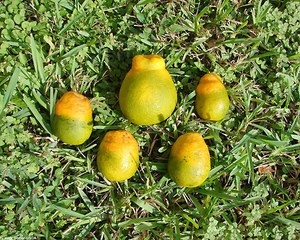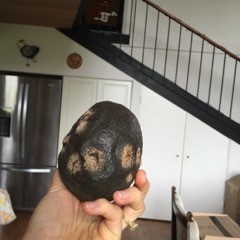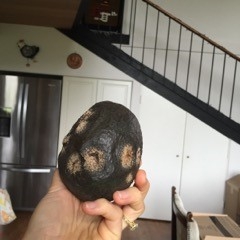- Author: Ben Faber
New ways of analyzing spectral data can distinguish between different diseases in olive and from drought stress in olive and almond. This technology is now being applied to citrus HLB.
Plant pathogens pose increasing threats to global food security, causing yield losses that exceed 30% in food-deficit regions. Xylella fastidiosa (Xf) represents the major transboundary plant pest and one of the world's most damaging pathogens in terms of socioeconomic impact. Spectral screening methods are critical to detect non-visual symptoms of early infection and prevent spread. However, the subtle pathogen-induced physiological alterations that are spectrally detectable are entangled with the dynamics of abiotic stresses. Here, using airborne spectroscopy and thermal scanning of areas covering more than one million trees of different species, infections and water stress levels, we reveal the existence of divergent pathogen- and host-specific spectral pathways that can disentangle biotic-induced symptoms. We demonstrate that uncoupling this biotic–abiotic spectral dynamics diminishes the uncertainty in the Xf detection to below 6% across different hosts. Assessing these deviating pathways against another harmful vascular pathogen that produces analogous symptoms, Verticillium dahliae, the divergent routes remained pathogen- and host-specific, revealing detection accuracies exceeding 92% across pathosystems. These urgently needed hyperspectral methods advance early detection of devastating pathogens to reduce the billions in crop losses worldwide.

- Author: Ben Faber
UAV-based Remote Sensing Can Help
Avocado Growers by
Detecting Asymptomatic Pathogen
GAINESVILLE, Fla. — Remote imaging can effectively detect a pathogen that endangers the $100 million-a-year Florida avocado industry – even before the trees show symptoms — University of Florida scientists say.
Yiannis Ampatzidis, an assistant professor of agricultural and biological engineering at the UF Institute of Food and Agricultural Sciences, led recently published research that shows that multispectral cameras can detect laurel wilt on avocado trees. The approach costs less than manually trying to detect the laurel wilt pathogen, Ampatzidis said, though UF/IFAS researchers don't know yet the cost differential.
Avocados provide an estimated $100 million-a-year economic benefit to the state's economy, according to UF/IFAS research. California grows most of the nation's avocados, but Florida is the second-leading producer. About 95 percent of Florida' avocados are grown in South Florida, particularly in Miami-Dade County. So UF/IFAS researchers first infected avocado trees with laurel wilt at the UF/IFAS Tropical Research and Education Center in Homestead, Florida.
Then they brought those trees to the UF/IFAS Citrus Research and Education Center in Lake Alfred, Florida, where Jaafar Abdulridha, a postdoctoral researcher for Ampatzidis, tested if the remote-sensing techniques would discern the laurel wilt pathogen. At the Citrus REC, UF/IFAS researchers identified wavelengths that they can use to detect laurel wilt early in avocados.
Multispectral cameras can capture data within specific wavelengths across the electromagnetic spectrum, said Ampatzidis, who specializes in precision agriculture. Humans can only see very small areas of the spectrum.
“In general, growers need to scout their field and visually detect infected plants,” said Ampatzidis, a faculty member at the UF/IFAS Southwest Florida Research and Education Center in Immokalee, Florida. “It is very time-consuming, labor-intensive and costly. And of course, they can only detect diseases based on their symptoms.”
“Using different filters, we can separate wavelengths,” he said. “So, these multispectral cameras are sensitive to particular wavelengths.”
The proposed system could detect diseases in asymptomatic stages, thus telling growers earlier that their trees are infected, he said. An unmanned aerial vehicle – or drone — with a multispectral camera can cost between $3,000 and $8,000, Ampatzidis said.
The new study is published in the journal Computers and Electronics in Agriculture.
-30-
By: Brad Buck, 352-294-3303, bradbuck@ufl.edu
The mission of the University of Florida Institute of Food and Agricultural Sciences is to develop knowledge relevant to agricultural, human and natural resources and to make that knowledge available to sustain and enhance the quality of human life. With more than a dozen research facilities, 67 county Extension offices, and award-winning students and faculty in the UF College of Agricultural and Life Sciences, UF/IFAS works to bring science-based solutions to the state's agricultural and natural resources industries, and all Florida residents. Visit the UF/IFAS web site at ifas.ufl.edu and follow us on social media at @UF_IFAS.





